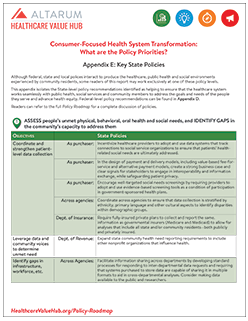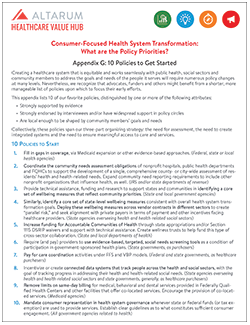Consumer-Focused Health System Transformation: What are the Policy Priorities?
Appendix E: Key State Policies
Although federal, state and local polices interact to produce the healthcare, public health and social environments experienced by community residents, some readers of this report may work exclusively at one of these policy levels.
This appendix isolates the state-level policy recommendations identified as helping to ensure that the healthcare system works seamlessly with public health, social services and community members to address the goals and needs of the people they serve and advance health equity. Federal-level policy recommendations can be found in Appendix D.
Readers can refer to the full Policy Roadmap for a complete discussion of policies.
| ASSESS people’s unmet physical, behavioral, oral health and social needs, and IDENTIFY GAPS in the community’s capacity to address them | |||||
|
OBJECTIVES |
STATE POLICIES |
||||
|
Coordinate and strengthen patient-level data collection |
As purchaser: |
Incentivize healthcare providers to adopt and use data systems that track connections to social service organizations to ensure that patients’ health-related social needs are ultimately addressed. |
|||
|
As purchaser: |
In the design of payment and delivery models, including value-based fee-for-service and alternative payment models, create a strong business case and clear signals for stakeholders to engage in interoperability and information exchange, while safeguarding patient privacy. |
||||
|
As purchaser: |
Encourage well-targeted social needs screenings by requiring providers to adopt and use evidence-based screening tools as a condition of participation in government-sponsored health plans. |
||||
|
Across agencies: |
Coordinate across agencies to ensure that data collection is stratified by ethnicity, primary language and other cultural aspects to identify disparities within demographic groups. |
||||
|
Dept. of Insurance: |
Require fully-insured private plans to collect and report the same.information as governmental insurers (Medicare and Medicaid) to allow for analyses that include all state and/or community residents—both publicly and privately insured. |
||||
|
Leverage data and community voices to determine unmet need |
Dept. of Revenue: |
Expand state community health need reporting requirements to include other nonprofit organizations that influence health. |
|||
|
Identify gaps in infrastructure, workforce, etc. |
Across Agencies: |
Facilitate information sharing across departments by developing standard processes for responding to inter-departmental data requests and requiring that systems purchased to store data are capable of sharing it in multiple formats to aid in cross-departmental analyses. Consider making data available to the public and researchers. |
|||
|
CREATE INTEGRATED SYSTEMS to advance population health |
|||||
|
OBJECTIVES |
STATE POLICIES |
||||
|
Align incentives to support population health goals |
Dept. of Revenue: |
Allow non-profit hospitals to report meaningful participation in an Accountable Communities for Health (ACH) as community benefit. |
|||
|
Dept. of Health: |
Increase funding for ACHs through state appropriations and/or Section 1115 DSRIP waivers and support with technical assistance. |
||||
|
Medicaid Agency: |
Incorporate provisions related to social determinants in Medicaid contracts. |
||||
|
Across Agencies: |
Adopt cross-sector population health accountability measures to align incentives across vendor contracts (“parallel risk”). |
||||
|
Increase funding for services to address social needs |
Across Agencies: |
Explore opportunities to use braiding, blending, global budgets and wellness trusts to break down financing silos that interfere with cross-sector collaboration. |
|||
|
Medicaid Agency: |
Pursue waivers to pay for housing-related services. |
||||
|
Integrate healthcare and community-based services |
As purchaser: |
Pay for care coordination activities under all types of provider payment models; couple these payments with outcome-based measures to ensure meaningful results; incentivize providers to use risk stratification or hotspotting to identify patients in need of coordinated care. |
|||
|
Medicaid Agency: |
File State Plan Amendments to authorize community health workerss (CHWs) to be reimbursed for preventive services; use Section 1115 waivers to reimburse CHWs through Medicaid; require Medicaid managed care plans to contract with community health workers, in addition to behavioral health and dental providers. |
||||
|
Dept. of Health |
Create line-items for CHWs in state budgets. |
||||
|
Dept. of Health |
Consider CHW certification to establish professional standards and define the CHW scope of practice. |
||||
|
Engage community members in transformation efforts |
Across Agencies: |
Have strong “open meetings” laws; hold meetings at times that are convenient for community members; assist with travel, childcare and translation services; and provide multiple avenues for public participation (online, in-person, etc.). Deploy principles of the Collective Impact Forum to ensure inclusiveness and impact. |
|||
|
Across Agencies: |
Mandate consumer representation in health system governance whenever federal funds (or tax exemption) are used to provide services. Establish clear guidelines as to what constitutes sufficient consumer engagement. |
||||
|
Across Agencies: |
Explore use of participatory budgeting to allocate public dollars in a way that is meaningful to communities, including in efforts to advance population health. |
||||
| ENSURE MEANINGFUL ACCESS to care and services that meet people’s goals and needs, especially within underserved communities | |||||
|
OBJECTIVES |
STATE POLICIES |
||||
|
Achieve universal, comprehensive coverage |
Legislature: |
Expand Medicaid, if not already done. |
|||
|
Dept. of Health: |
Use state flexibility offered under 1332 waivers or another approach to further expand comprehensive, affordable coverage; commission research to establish an evidence-based, fair “affordability standard” for healthcare. |
||||
|
Across Agencies: |
Integrate eligibility requirements across Medicaid, SNAP and other safety net programs to support a “no wrong door” approach to enrollment. Minimize the complexity of complying with these requirements. |
||||
|
As purchaser: |
Keep cost-sharing design as simple as possible and evidence-based; also, require provider networks be tailored to community needs, including pathways to public health and social service providers as needed. |
||||
|
Across Agencies: |
If a single payer approach is not used, strive to achieve alignment across public and private payers with respect to priorities, measures for success, payment approaches and other incentives facing to providers. |
||||
|
Address provider shortages in underserved areas; increase diversity among providers |
Dept. of Health: |
Increase loan repayment and scholarships to incent primary care, dental and behavioral health providers to serve in underserved areas, including non-physician providers; invest in pipeline programs and reduce barriers to training for students coming from underserved communities. |
|||
|
Dept. of Health |
Broaden non-physician providers’ “scope of practice” and/or create new categories of medical and dental providers with expanded authority, consistent with evidence and community needs; require Medicaid managed care plans and/or Qualified Health Plans to include non-physician providers in their networks and consider appropriate payment rates. |
||||
|
Tailor care delivery settings to community needs |
Medicaid Agency: |
Remove limits on same-day billing for medical and dental services provided in Federally Qualified Health Centers and other facilities that offer co-located services. Encourage the provision of co-located services. |
|||
|
Medicaid Agency: |
Broaden the scope of telemedicine services, settings and providers eligible for reimbursement under Medicaid. |
||||
|
Dept. of Health: |
Adopt the Interstate Medical Licensure Compact to better enable clinicians to provide telemedicine services across state lines; Similarly, the Enhanced Nurses Licensure Compact, the Physical Therapy Compact and the soon-to-be-operational Psychology Interjurisdictional Compact. |
||||
|
Legislature: |
Pass legislation requiring private payers to reimburse for identical telemedicine services, setting and providers as the state Medicaid program. |
||||
|
Make clinical care more patient-centered |
As purchaser: |
Make shared decision-making as the standard of care, providing reimbursement, technical assistance with decision aids and an on-ramp that supports a culture shift. |
|||
|
Dept. of Health: |
Require hospitals to adopt patient and family advisory councils and adhere to best practices with regards to Council design. |
||||
|
Use measurement and feedback systems to judge performance |
Across Agencies: |
Use a multi-stakeholder process to identify a core set of measures that reflect community priorities, to be used to assess overall system progress towards goals. Align these overall system measures with performance measures used with vendors. |
|||
|
Across Agencies: |
Identify/establish a diversity of feedback mechanisms to measure progress towards these system performance measures. |
||||








